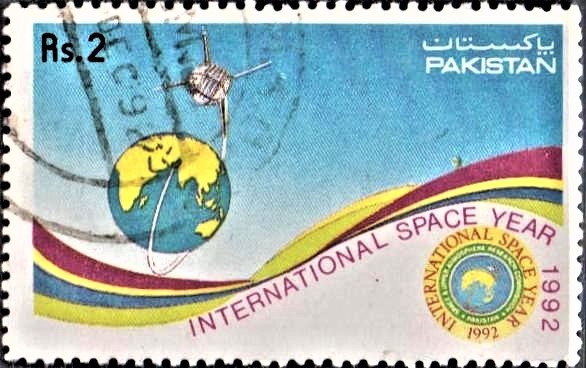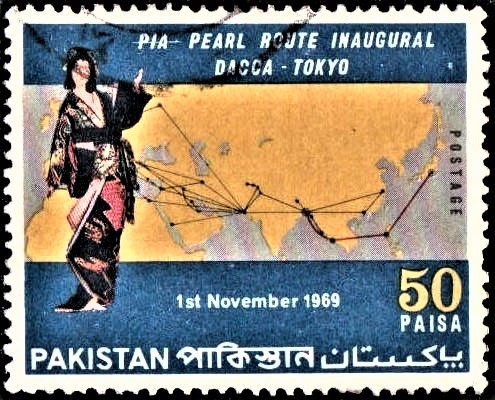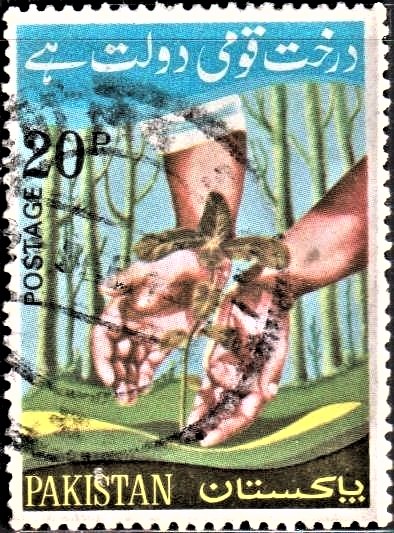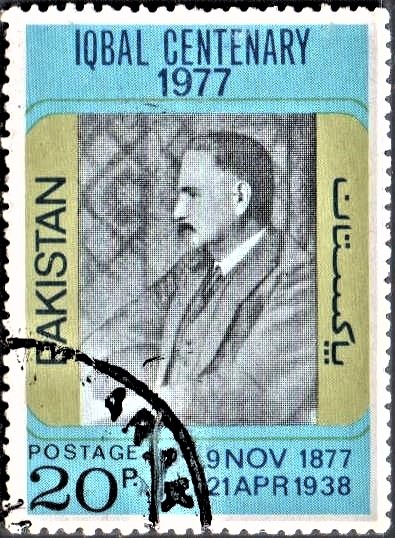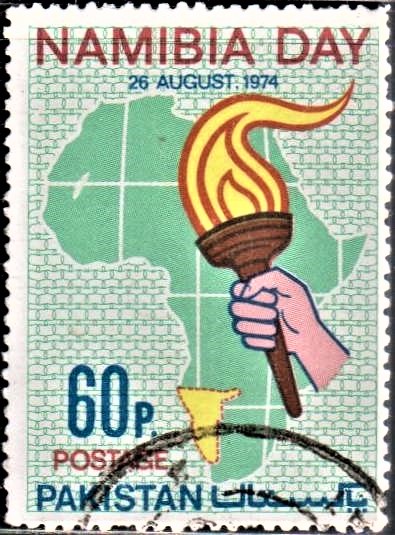
Pakistan on Namibia Day
A commemorative postage stamp on the Namibia Heroes Day :
 Issued by Pakistan
Issued by Pakistan
Issued on Aug 26, 1974
Design : The stamp is vertical in format. The map of the continent of Africa showing boundaries of Namibia in Yellow colour appears in the background. On the map a hand holding up a torch of freedom is shown in Red, Yellow and Brown colours symbolising the struggle for freedom.
Type : Stamp, Postal Used
Denomination : 60 Paisa
Colours : Light Green / Yellow / Red / Ultra–marine
Size of Stamp : 44.5 x 32.5 m.m.
Size of print : 41.5 x 29.5 m.m.
Perforation Gauge : 13 x 13 C
Quantity printed : 5,00,000
Number of stamps in each sheet : 50 (fifty)
Printing Process : Litho Offset
Printers : The Pakistan Security Printing Corporation Ltd., Karachi
About :
- The General Assembly in its 28th session adopted a resolution by which it decided to commemorate the 26th of August each year as Namibia Day. Pakistan is an active member of the UN Council for Namibia which also happens to be the sole de-jure administering authority of Namibia. It has therefore, become incumbent upon Pakistan to contribute as much as possible towards the struggle in Namibia and to explore ways and means of projecting the Namibian Liberation Movement before the world. Pakistan Post Office has accordingly brought out a 60-Paisa Commemorative Postage Stamp to highlight the occasion.
- Namibia lies along the South Atlantic Ocean and borders on South Africa, the Portuguese-administered Territory of Angola, Zambia and Botswana. Its area of 318,261 square miles can be divided into three regions: the Namib, the Central Plateau and the Kalahari. The Namib an arid and desolate region, is a coastal belt from 40 to 80 miles wide. The Central Plateau covers slightly more than half of the territory’s land area. The Kalahari, composed of level monotonous plains covered with sand dunes and with virtually no surface water, is in the northern and eastern parts of Namibia. Namibia has a population of 746,328 of which 90,658 are European settlers of German and South African origin. The Africans constitute more than 80% of Namibia’s population.
- The UN Charter provided for a trusteeship system to deal with the question of mandated and other non-self governing territories. The Charter set up a Trusteeship Council to work with the administering powers in bringing about the independence of all non-self-governing territories. The Union of South Africa, however, refused to submit its mandated territory in trusteeship.
- However, the issue of South–West Africa continued to occupy the attention of the General Assembly, which called for further advisory, opinions, in 1955 and 1956, but was unable to make much progress in the case of South Africa’s recalcitrance. In 1960, a case was brought in the International Court of Justice against South Africa in which judgement was sought to the effect that South Africa had violated the 1920 mandate by introducing the policy of apartheid. In 1960, however, unexpectedly the Court announced that it had no power to render a decision, thus dismissing the case without ruling on its merits. The General Assembly by its resolution 2145 (XXI) of 27 October 1966 terminated the Mandate of the Republic of South Africa over South West Africa and assumed direct responsibility for the administration of the territory until its independence. The Assembly declared that South Africa had hence forth no right to administer the territory and called upon it to refrain and desist from any action – political, constitutional or administrative that would in any manner alter the international status of the territory.
- On the request of 45 African-Asian states including Pakistan and Yugoslavia, a meeting of the Security Council was held on 20th March, 1969 to consider the deteriorating situation in Namibia resulting from the policies of the Government of South Africa in contravention of various General Assembly and Security Council resolutions. A resolution [264 (1969)] was adopted by which the Council called upon South Africa to withdraw its administration immediately from Namibia. It invited all states to exert their influence to obtain such a withdrawal.
- South Africa rejected the above resolution of the Security Council. Thereupon the Council adopted another resolution [269 (1969)] by which it, inter alia, reaffirmed its resolution [264 (1969)] and condemned the Government of South Africa for its refusal to comply with that resolution and called upon the Government of South Africa to withdraw its administration from the territory immediately and in any case before 4 October, 1969 and decided that in the event of failure on the part of the South African Government to comply with this provision, the Council would meet immediately to decide upon effective measures in accordance with the appropriate provisions of the relevant Chapters of the United Nations Charter.
- At the twenty-eighth session, the General Assembly adopted resolution 3111 (XXVIII), with Pakistan voting in favour, by which it designated the UN Council for Namibia, as the legal authority for Namibia to participate fully on behalf of Namibia and to render, within their spheres of competence, all possible assistance to the Namibian people and their liberation movement. The Assembly also allocated to the United Nations Fund for Namibia a sum of 100,000 dollars from the regular budget of the UN for 1974 and appointed the United Nations Council for Namibia as trustee of the Fund and invited all member states to transmit or present their views on the orientation of the Fund to the Council. Furthermore, the General Assembly approved the proposal of the Secretary-General to appoint Mr. Sean MacBride, former Minister for Foreign Affairs of Ireland, as UN Commissioner for Namibia for an initial period of one year.
- Instead of complying with the repeated calls to end its illegal occupation of Namibia the South African Government has tightened it stranglehold on the territory depriving its people of their wealth and their rights and ability to develop into a free, self-supporting nation. It has built up its own military strength within the country and has adopted measures which have led to all but official annexation of the territory.
- The degree of technical refinement to which the application of apartheid has been brought in Namibia has earned South Africa the dubious place as the leader of racist regimes. An abundance of evidence has made it all too clear that the existence and lives of native African’s within the system of apartheid serves no other purpose than to further economic advantage of the white minority. Thus the African has come to be regarded as little more than a commodity to be exploited. This is a far cry from the right “to life, liberty and security” which the Universal Declaration of Human Rights seeks to uphold. If a tragedy is to be avoided in Namibia, it will only be as the result of an effort by deeds more than words of the community of nations together and in the individual capacity to free the Namibian people from the yoke of South African rule. To fail in Namibia now, and ultimately in South Africa itself, is to be accessory to the crimes committed there and to share in what has already become a blot on civilization.
- Issued by The Director General, Pakistan Post Office, Karachi.



